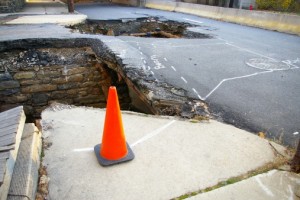If you have been injured due to the dangerous condition of property owned by the State, a county or a municipal or other local governmental body, you should know that these “public entities” are responsible for injuries caused by the dangerous condition of their property only in accordance with the terms of the New Jersey Tort Claims Act, N.J.S.A. 59:1-1 et seq. In order to recover damages for personal injuries caused by the hazardous condition of public property, a plaintiff must prove each of the following five elements:
1. That the property was in a dangerous condition at the time of the injury. In other words, it must be demonstrated that the condition of the property created “a substantial risk of injury when the property is used with due care and in a manner in which it is foreseeable for the property to be used”;
2. That the injury was proximately caused by the dangerous condition of the property. That is, that the dangerous condition naturally and probably led to the injury alleged;
3. That the dangerous condition created a foreseeable risk of the kind of injury alleged to have occurred;
4. That the public entity had actual or constructive notice of the dangerous condition in sufficient time prior to the injury to protect against the dangerous condition or that an employee of the public entity created the dangerous condition; and
5. That any measures taken by the public entity, or its failure to take any measures, were “palpably unreasonable”.
 Elements four and five are what make recovering damages against a public entity more difficult than recovering damages against a private person or business. With respect to element four, a public entity is deemed to have actual notice of a dangerous condition if it had actual knowledge of the condition and knew or should have known of its dangerous character. Constructive notice can be demonstrated if the condition existed for a long period of time and was so obvious that the public entity, exercising due care, should have discovered the condition and its dangerous character. Finally, as to element five, proving ordinary negligence is insufficient. A plaintiff must prove that the action or inaction of the public entity in addressing the dangerous condition was “plainly and obviously without reason or a reasonable basis.” The public entity’s actions or inaction must be deemed capricious, arbitrary and outrageous.
Elements four and five are what make recovering damages against a public entity more difficult than recovering damages against a private person or business. With respect to element four, a public entity is deemed to have actual notice of a dangerous condition if it had actual knowledge of the condition and knew or should have known of its dangerous character. Constructive notice can be demonstrated if the condition existed for a long period of time and was so obvious that the public entity, exercising due care, should have discovered the condition and its dangerous character. Finally, as to element five, proving ordinary negligence is insufficient. A plaintiff must prove that the action or inaction of the public entity in addressing the dangerous condition was “plainly and obviously without reason or a reasonable basis.” The public entity’s actions or inaction must be deemed capricious, arbitrary and outrageous.
Clearly, the Tort Claims Act presents substantial evidentiary hurdles to recovery for persons injured due to the dangerous condition of public property. This is so, in part, because public entities often face difficult decisions with regard to the allocation of limited public resources. As such, a public entity is not required under the law to do everything that might be done. However, where a public entity acts in a palpably unreasonable manner, a plaintiff is entitled to compensation for injuries caused by the public entity’s actions or inaction.
If you have been injured due to the dangerous condition of public property, contact the accident lawyers of Ginarte, Gonzalez & Winograd, LLP today. Call (888) GINARTE for a free consultation on your case and to see how we can help you.
